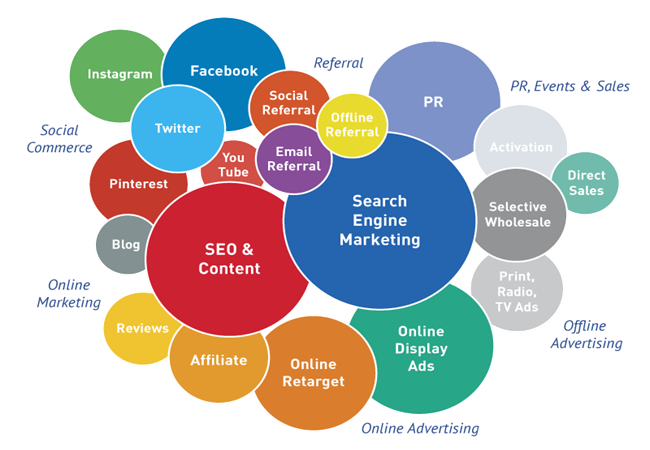
Deep into the internet age, it is rare to find someone who does not run their own website: whether it is as a freelancer, to promote their hobby, or f their business. In fact, with over 70 million new posts being published on WordPress each month alone, is it any wonder that blogging, content and digital marketing have become core tenets of the modern marketer’s strategy?
At least 65% of content marketers report operating with a fully-fledged, documented marketing strategy to push their websites, and drive traffic toward them. That means that for the rest of us out here, trying to grow the popularity of our site among our intended audience, we have our work cut out for us.
Which is exactly why we have chosen to write this article: to give you 6 tried-and-tested, simple yet effective methods to teach you how to promote your website successfully in 2023. By the time you have finished reading, we are confident that you will have picked up the necessary know-how to take your site – be it blog or online store – to the next level.
Method 1: Start a Blog
In some senses, blogging seems so 2000s, doesn’t it? Back in the golden days of the internet, when blogs and forums were about all that existed, and Tumblr ruled the waves. Certainly, blogging has its roots in the personal opinion pieces posted to sites like Tumblr, but today is a roaring industry more attuned to the needs of businesses who wish to increase traffic and conversion on their main site.
Starting a blog requires a little research and a little planning – research into the competition (what other people in your industry are writing about), and planning to ensure you produce and post content regularly, accurately, efficiently, and in-line with Google’s SEO rules. However, once you’ve got your blog off the ground, it can serve you as a sort of customer honey-trap: they come looking for advice and information, and are afterwards redirected to your website.
Method 2: Utilize the Power of Social Media
With so many varied SM Channels to create your business page available; you might be wondering which one do I choose. Try not to get up in the hype. Reality is in the USA, the average person spends time on 6.6 social media platforms. What this means is that your reach across multiple channels is duplicated.!
Of course it is important to be where your users are. Facebook has the largest percent of the population (which is still under 1%). YouTube has 2%. The most important thing is to know where your users are; what your Ad ROI is and how to know if your AD works with users.
Method 3: Submit Your Site to Online Directories
Submitting both websites and blogs to online directories is typically one of the most cost-effective methods of growing your site. Oftentimes submitting your site to online directories is completely free, and requires little more than your time. By submitting to directories, you build up a portfolio of places linking back to your website, which over time can help internet users find your and consequently increase traffic to your site.
Online directories are split into three major categories: search engines, paid website directories and paid blog directories. Submitting your site to search engine directories like Google, Bing and Yahoo! is essential to ensure your site’s success, whilst submission to paid directories should be approached a little more cautiously. Do your research and make sure that the paid directories you are looking at are accessed by your target audience – if they are, go for it! This is a great way to generate authentic interest in your site.
Method 4: Start and Email Campaign
Just like we almost all use social media, we also almost all find ourselves absentmindedly checking our personal and work emails on a daily – if not hourly – basis. Email marketing capitalizes on this habit by sending relevant, enticing, and useful emails to people who have signed-up to our website or newsletter.
Just because someone may have chosen to enter their details the first time, they purchased something from your store or read one of your articles does not mean that you now have a new loyal customer or client. Email marketing is a way of reconnecting with this score of lapsed potential, and encouraging people to revisit your site. Just remember to keep your email content brief, to the point, and engaging – you want people to click on your links, not delete the email out of boredom.

Method 5: Content Marketing
Content, or so they say, is king. Just look around you the next time you find yourself on public transport or… well, honestly? Anywhere in public. Everyone is on their smartphone, and everyone is consuming “content”. ‘Content’ is a catch–all term for consumable digital media. Its most recognizable form is the meme, or short clip – i.e., a very visual type of content. However, content can also include blog posts, music tracks, TV episodes, podcasts, and so on.
Because we love consuming content, via social media or entertainment platforms like YouTube, we have of course also worked out how to market it: by including affiliated links in the content, or referencing things – in this case, our website – which we want to promote.
Content marketing to promote your website requires you to focus on two things in particular: quality and SEO. Look at what’s trending, what is hot, what sells, and break it down so that you can apply similar features to your own, original content. Next, research SEO best practices to ensure that the content you produced is optimized for search engines like Google.
Method 6: Old School Techniques
Before websites businesses used many techniques to drive customers to their business. This is where you need to get creative, and you still want to use your website to capture the traffic generated by these strategies.